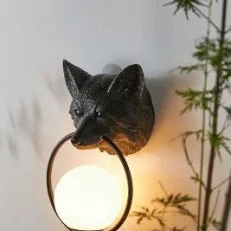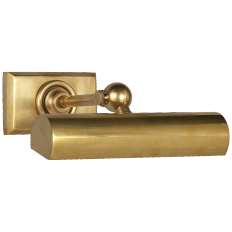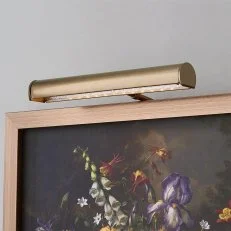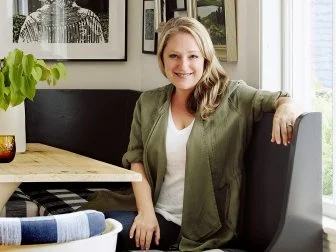How to Find the Right Lighting for Any Space, According to Kristina Crestin of 'Farmhouse Fixer'
HGTV's Kristina Crestin is obsessed with lighting — and she's giving us her best tips, tricks and product recommendations so we can pull off sweet lighting looks in our own homes.

Jared Kuzia Photography
Kristina Crestin of Farmhouse Fixer makes lighting a top priority in all of her designs, including this epic farmhouse kitchen.
When designing a home, lighting is notoriously one of the toughest elements to pull off. Luckily for us, Kristina Crestin — creative extraordinaire and Farmhouse Fixer designer — knows a thing or two about finding the right fixtures.
In fact, she’s obsessed with it.
Below Kristina shares some of her best lighting tips — including how to choose complementary and consistent pieces, incorporate showstoppers, determine size and more. She also reveals some of her favorite lighting accessories. (And the best part? You can buy her picks for your own space.)

Jared Kuzia
Rustic pendants hang over this sleek kitchen island from Season 3 of Farmhouse Fixer.
The Basics: Size and Finish
When it comes to picking out lighting for any space, Kristina recommends “planning, planning, planning."
First, Find the Right Size
“Before you start looking, you really need to know what scale you’re after,” says Kristina. “I find many times people go too small with lighting.”
The key is to pay attention to the room’s furnishings. For example, if you're hanging lights in a kitchen above an island, knowing the length of the island is important when determining pendant or sconce size. Kristina often mocks up a space using balloons or buckets as lights, taping them or hanging them up so clients can see how big their desired light fixture will look. “It makes a difference when you can visualize,” she says.

Jared Kuzia
This elegant dining room features pendant lighting designed by Kristina during Season 3 of Farmhouse Fixer.
Another guideline: The bottom of a fixture should sit 30 inches above a dining table or kitchen counter. “That's the gold standard in interior design,” Kristina says. “It's usually what looks best in the room, regardless of if you have 10-foot ceilings or 7-foot ceilings" — and it looks better than tucking up a fixture too high, she says.
“Start with knowing what the lowest possible (fixture) height is and what your ceiling height is to calculate your max possible fixture size,” she recommends.
Shop This Lighting Look
Second, Determine Finishes
Lighting finishes can get tricky, but Kristina has some rules. (Though rules are sometimes meant to be broken, so don’t be afraid to get a little creative.)
One option: Keep finishes consistent with the hardware and accessories throughout a room. This is a particularly enticing option for Kristina if she’s aiming to use an unexpected or striking finish — for example, the brass hardware and lighting in the below mini bar vignette, which adds a touch of refined glamor. “I’ll go with an unexpected finish only if I've checked that I can get all the [matching] pieces I want,” Kristina says.

Jared Kuzia
Brass hardware and a matching brass pendant add a touch a glamour to this decked-out mini bar.
Another option: “Sometimes a light fixture can help bridge a finishing mixing issue,” Kristina says. For instance, if a faucet is brass and the cabinet hardware is black, a sconce that incorporates both brass and iron can pull all the materials together.
Finally, if you’re having a hard time finding lighting to match your hardware and you’re not a fan of mixing metals, try using lighting made with non-metal materials. “I’ve been using a lot of ceramic lately for both pendants and surface mounts,” Kristina reveals.
Shop Kristina's Non-Metal Lighting Picks
Designing for Lighting: How to Shop for Fixtures
Once sizing and finishes have been decided, you’re ready for the fun part: shopping.
Opt for Decorative Over Recessed
“Decorative lighting brings so much more character and interest into a space than recessed lighting,” Kristina says. “I think about lighting like dressing, particularly in open-concept homes where multiple light fixtures are visible,” she says.
If a client loves a particular statement light fixture, Kristina will create the room’s design around it and choose lighting to complement it. (See above for how to decide on size and finish.) “Don't discount decorative lighting if you have time to plan,” she says.

Jared Kuzia
Kristina used simple black surface mounted lighting on the ceiling of this primary bath, letting the stunning tub and old-school vanity sconces shine.
Kristina also gravitates towards unexpected or colorful fixtures, and if she can’t find exactly what she wants, she’ll get creative by spray painting or customizing it.
And Kristina makes it clear that lighting doesn’t always need to be “a showstopper” to be decorative. “Sometimes a quiet moment of a plain fixture [installed] in a repeating pattern works,” Kristina says, especially if there’s another wow-moment happening in the space (bold lighting or otherwise).
Shop Kristina's Decorative Lighting Picks
Lean Into Surface Mounts
Even in a hallway or a mudroom — where recessed lighting is most common — Kristina suggests installing surface mounts (functional and/or decorative fixtures that attach lights directly to ceilings or walls). “There are so many interesting [surface mount] shades and colors out there,” she says.
Choosing a colored, simple surface mount and installing it in a repeating pattern can add playfulness, too.
Shop Kristina's Favorite Mounted Lighting
Illuminate Your Art

Gilles Mingasson
A picture light illuminates art as seen in Kristina and Jonathan Knight's Season 4 Rock the Block home.
If time allows in the planning process, “A well placed art light really dresses up a space and adds a lovely glow in the evening,” Kristina says. It’s a tactic she uses in her interior design work frequently. Bonus: You can find them in both hardwired or plug-in options for when you have time to add an electrical box, or when you don’t.
Shop Kristina's Favorite Picture Lights












































